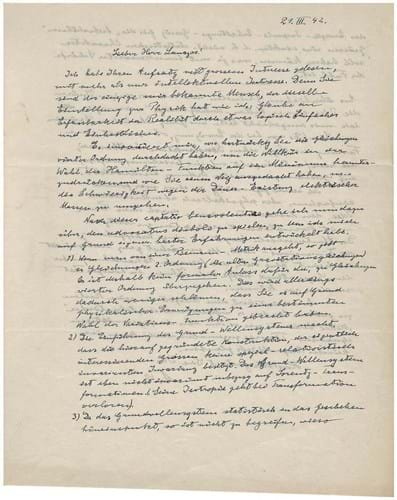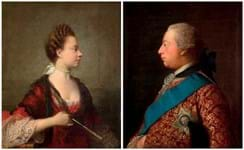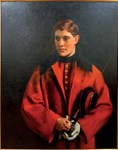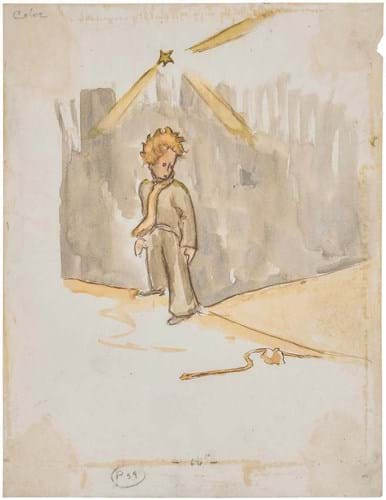
This original watercolour of the Little Prince which fetched a record £240,000 at Christie’s depicts the character just after his arrival on earth and his meeting with a snake with whom he converses.
This was the highest price in the single-owner online sale at Christie’s (26/21/15% buyer’s premium) in London titled The Alphabet of Genius: Important Autograph Letters and Manuscripts, which closed in two parts on December 14-15.
It was billed by the auction house as “one of the most important libraries of autograph letters and manuscripts to have been offered for sale in recent decades”.
The Little Prince is one of the top-selling books in history, having sold an estimated 140 million copies, and is often quoted as the most translated book after the bible.
First published in New York in April 1943 in French and English editions, the auction house noted that original drawings and watercolours for The Little Prince ‘in their near-complete or final versions are of the utmost interest and scarcity’.
Most of the known examples are in institutional holdings, notably in the Morgan Library in New York.
The Christie’s result was not without precedent, however, as two comparable watercolours had been sold at auction in 2017 by Artcurial in Paris for €283,500 and €217,500 respectively (including buyer’s premium).
With these auction records, the estimate of £25,000-35,000 certainly seemed low and bidders agreed.
Wide range
The sale of 365 lots encompassed a wide range of manuscript culture from Mozart to JRR Tolkien and ranged in date from a letter of 1531 written to Michelangelo by his pupil Antonio Mini (£30,000) to an autograph music manuscript of the 1970s by American composer John Cage (£6500).
Christie’s manuscript specialist Sophie Hopkins said that “it was gratifying to re-engage with buyers from the [Alibin] Schram sale of autograph letters [Christie’s, 2007] and also to attract a new generation of buyers who will be active over the coming years.”
Hopkins also noted that online sales were good at attracting new buyers who regularly buy online and that bidding was particularly strong from the US, the UK and Continental Europe, with fewer bids from China than has been seen in recent years.
The Alphabet of Genius sale certainly contained a wealth of extraordinary human stories, thoughts and ideas in manuscript form.
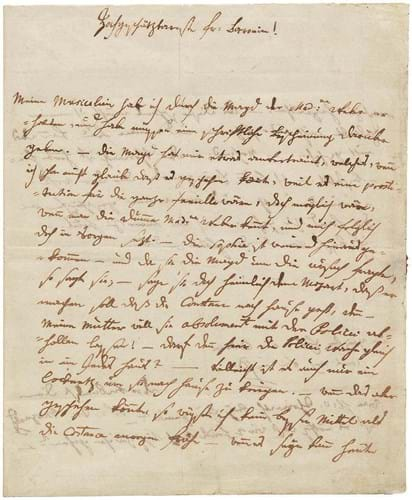
Sold for £180,000 at Christie's, this extraordinary letter was written by the 26-year-old Mozart to his close friend Baroness von Waldstätten about his urgent need to marry Constanze Weber.
One such example was a letter written by Mozart at the age of 26 with great urgency to his close friend Baroness von Waldstätten telling her that he must get married “tomorrow morning – today if possible”, in order to prevent his future mother-in-law calling the police to “rescue” her daughter Constanze Weber and “save her reputation” as an unmarried lady.
Letters by Mozart are rare at auction and this example had been offered in Christie’s Exceptional Sale in July with an estimate of £300,000-500,000 but had failed to find a buyer; this time, with a halved estimate of £150,000-200,000, two bidders competed and the letter sold for £180,000, making it the third-highest auction price for a Mozart letter.
Mahler manuscript
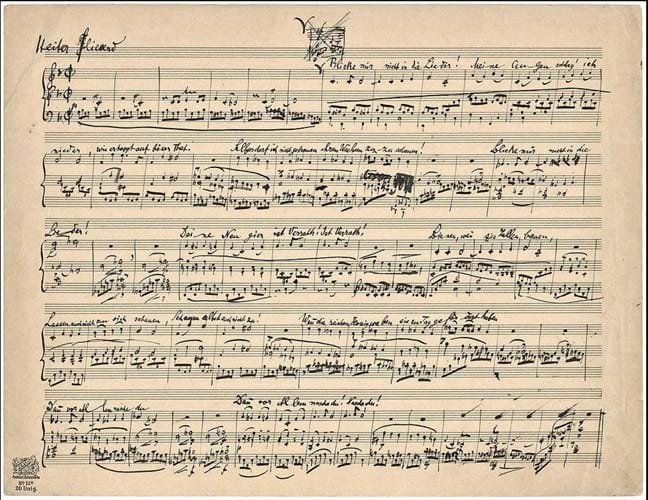
A rare survival of one of Mahler’s working manuscripts, showing his composition for the song Blicke mir nicht in die Lieder from the Rückert-Lieder, £85,000 at Christie's.
Many musical manuscripts featured in the sale and leading them was an autograph working manuscript by Mahler for the song ‘Blicke mir nicht in die Lieder’ from the Rückert-Lieder, composed alongside the Kindertotenlieder and the Fifth Symphony.
This manuscript written in June 1901 contained the piano-score for the complete song notated in black ink with autograph alterations and cancellations in ink, pencil and blue crayon.
The catalogue noted that “for the most part, Mahler destroyed the preparatory work for his compositions: the material that survives, whether in private hands or institutional collections, represents only a selection surviving by chance”.
The manuscript sold just below estimate at £85,000 hammer.
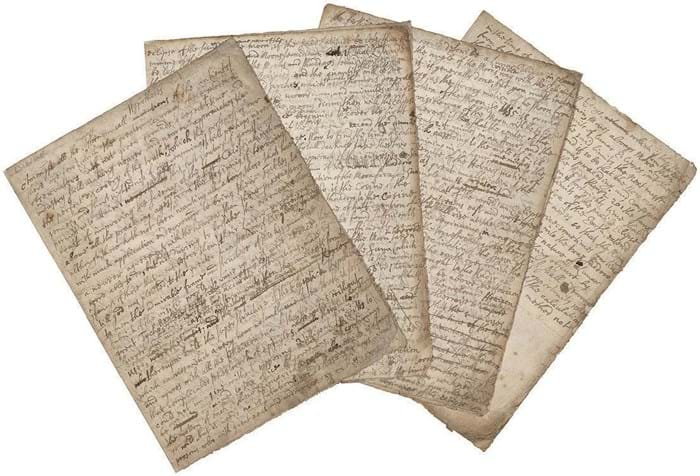
These two unpublished draft autograph manuscripts by Edmond Halley, on lunar and solar eclipses c.1690-55, sold for more than double their low estimate at £160,000 hammer at Christie's.
Two autograph manuscripts by the scientist Edmond Halley (1656-1742) offered as a single lot stood out for their rarity, as only two other manuscripts by him are noted in auction records.
The documents were believed to be unpublished drafts of papers read by Halley before the Royal Society in 1692 on the subject of recent lunar and solar eclipses. Halley mentions astronomer contemporaries including Johannes Hevelius and John Flamsteed, and the appearance of eclipses in the New World.
There was much competition for these documents, notably from the US, and although estimated at £70,000-100,000 it took a bid of £160,000 hammer to buy them.
Einstein letters
Several letters by Albert Einstein were offered in the auction, among them one written during the Second World War to the Hungarian mathematician Cornelius Lanczos.
In the letter Einstein states, in German, that “it seems hard to get a sight of what God’s cards are. But I cannot believe for an instant that he plays dice.”
Einstein often used the phrase “God does not play dice with the universe” to express his belief in a universe governed by deterministic laws.
The letter sold for £75,000 hammer, triple the low estimate.

This manuscript by Louis Pasteur records his experiments and microscopic observations on the fermentation process in wine. At Christie’s it fetched an auction record for Pasteur, selling for seven times its estimate at £70,000.
An important autograph notebook by Louis Pasteur recording his scientific experiments and microscopic observations made in Arbois in 1858 had not been seen since it was last sold at Christie’s New York in 1984.
The notebook included Pasteur’s observations on the fermentation process of wine and disproved the theory that fermentation was caused by decomposition, demonstrating instead that yeast was responsible for fermentation to produce alcohol from sugar.
This small notebook containing just 10 written pages, with illustrations by Pasteur, was estimated at £10,000-15,000 but attracted a large number of bids and sold for a hammer price of £70,000 – a new auction record for Pasteur.
Anti-slavery poem
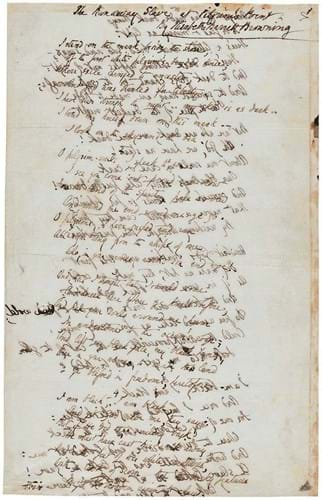
It took a bid of £75,000 at Christie's to secure this manuscript by Elizabeth Barrett Browning of her final draft of The Runaway Slave at Pilgrim’s Point, her anti-slavery polemic.
A literary highlight in the sale was an autograph manuscript by Elizabeth Barrett Browning, being the final draft of her anti-slavery polemic The Runaway Slave at Pilgrim’s Point.
This had been sent by Browning to the American poet James Russell Lowell to be included in the abolitionist compilation, The Liberty Bell.
Browning had been asked by Lowell to submit a poem for the publication and Browning was happy to accept, although she confided to her former tutor Hugh Boyd: “I am just sending off an anti-slavery poem for America, too ferocious, perhaps, for the Americans to publish: but they asked for a poem and shall have it.”
As a whole the auction total hit £2.6m, just shy of its £2.65m low estimate, achieved in no small part due to the success of The Little Prince drawing.


